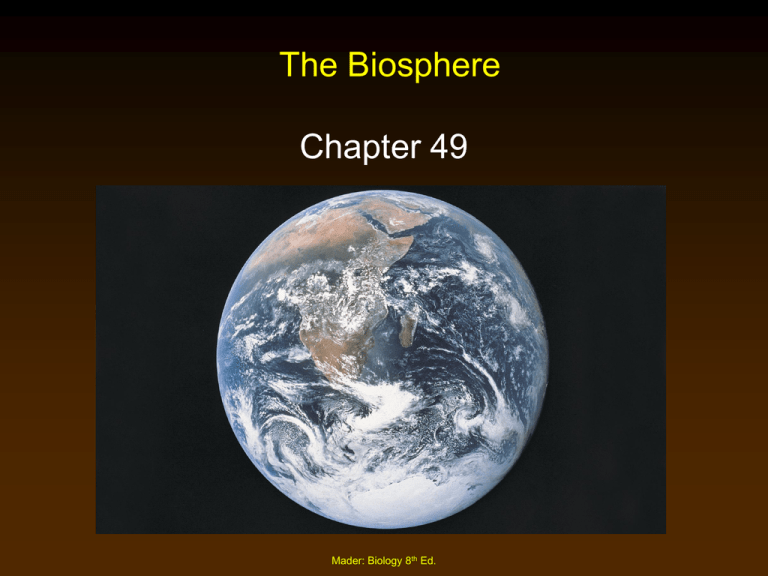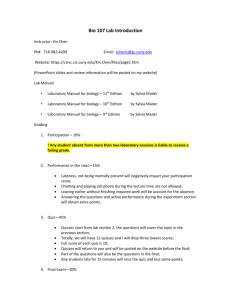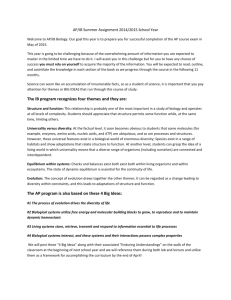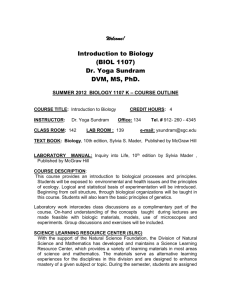Chapter 49 Biosphere
advertisement

The Biosphere Chapter 49 Mader: Biology 8th Ed. Outline • • • Climate and the Biosphere – Global Wind Circulation Terrestrial Communities Aquatic Communities – Life Zones – Lakes – Estuaries – Seashores – Oceans Mader: Biology 8th Ed. Climate and the Biosphere • Climate refers to prevailing weather conditions in a region. – Dictated by temperature and precipitation. Influenced by a multitude of factors including tilt of the earth’s axis and topography. Mader: Biology 8th Ed. Effect of Solar Radiation • Distribution of solar energy due to a spherical planet and the rotation and path of the Earth around the sun affect how the wind blows and the amount of rainfall various regions receive. Mader: Biology 8th Ed. Global Wind Circulation Mader: Biology 8th Ed. Rain Shadow • As winds cross a coastal mountain range, they rise and release their moisture on the windward side of the mountain. – Leeward side receives relatively little rain and is said to lie in a rain shadow. Mader: Biology 8th Ed. Formation of a Rain Shadow Mader: Biology 8th Ed. Terrestrial Communities • Biome has a particular mix of plants and animals adapted to living under certain environmental conditions. – Often delineated by climate. Temperature and precipitation varies according to latitude and altitude. Mader: Biology 8th Ed. Biome Distribution Mader: Biology 8th Ed. Climate and Biomes Mader: Biology 8th Ed. Tundra • Arctic tundra encircles Earth just south of ice-covered polar seas in Northern Hemisphere. – Covers 20% of Earth’s land surface. Trees are not found in the tundra because growing season is too short. Roots cannot penetrate permafrost. Mader: Biology 8th Ed. Tundra Mader: Biology 8th Ed. Coniferous Forests • • Taiga typifies coniferous forest with conebearing trees. – Trees well adapted to cold. Leaves and bark have thick covering. Needle-like leaves can withstand weight of heavy snowfall. Temperate Rainforest (Old-Growth Forests) of Pacific Northwest. – Evergreen forest. Mader: Biology 8th Ed. Temperate Deciduous Forests • Found south of taiga in eastern North America, eastern Asia, and much of Europe. – Well defined season with long growing seasons. – Tallest trees form a canopy. – Ground-life is plentiful. Mader: Biology 8th Ed. Temperate Deciduous Forest Mader: Biology 8th Ed. Tropical Forests • Found in equatorial regions. – Plentiful rainfall. – Most animals live in trees. Abundant insect life. – Epiphytes grow in many areas. – Soils are nutrient-poor. Rapid recycling of nutrients. – Swidden agriculture successful but destructive. Mader: Biology 8th Ed. Shrublands • Tend to occur along coasts that have dry summers and receive most of their rainfall in the winter. – Shrubs adapted to withstand arid conditions. – Dense shrubland in California known as chaparral. Mader: Biology 8th Ed. Grasslands • Grasslands occur where annual rainfall is greater than 25 cm, but generally insufficient to support trees. – Grasses well adapted to changing environment. – Temperate Grasslands – Savannas Mader: Biology 8th Ed. Temperate Grassland Mader: Biology 8th Ed. Savanna Mader: Biology 8th Ed. Deserts • Usually found at latitudes of about 30o in both north and south hemispheres. – Descending winds lack moisture. Annual rainfall less than 25 cm. – Large temperature differential between day and night. Mader: Biology 8th Ed. Deserts Mader: Biology 8th Ed. Aquatic Communities • Lakes – Bodies of water classified by their nutrient status. Oligotrophic - Nutrient-poor. Eutrophic - Nutrient-rich. – Lake Stratification In temperate zones, deep lakes are stratified in the summer and winter. Mader: Biology 8th Ed. Mader: Biology 8th Ed. Life Zones • • Plankton are important community components in fresh water and salt water. – Phytoplankton - Algae – Zooplankton - Animals Life Zones – Littoral zone - Closest to shore. – Limnetic zone - Sunlit areas. – Profundal zone - Below light penetration. – Benthic zone - Soil-Water interface. Mader: Biology 8th Ed. Zones of a Lake Mader: Biology 8th Ed. Coastal Communities • Estuaries – Partially enclosed bodies of water where fresh water and seawater meet and mix. Organisms must be able to adapt to changing salinity. Estimated over half of all marine fishes develop in protective environment of estuaries. Mader: Biology 8th Ed. Estuary Structure and Function Mader: Biology 8th Ed. Seashores • Littoral zone lies between high and low water marks. – Littoral zone of rocky beach divided into subzones. – Organisms cannot attach to shifting, unstable sands; therefore nearly all permanent residents dwell underground. Mader: Biology 8th Ed. Seacoasts Mader: Biology 8th Ed. Oceans • Major ocean currents move heat from the equator to cooler parts of the biosphere. – Gulf Stream warms east coast of North America and parts of Europe. – El Nino Southern Oscillation Cold upwelling off west coast of South America subsides. Mader: Biology 8th Ed. Ocean Currents Mader: Biology 8th Ed. Oceans • Pelagic Division – Neritic Province High concentration of organisms due to sunlight penetration and supply of inorganic nutrients. Coral Reefs Oceanic Province Lacks inorganic nutrients and thus does not have high concentration of phytoplankton. Mader: Biology 8th Ed. Mader: Biology 8th Ed. Oceans • Benthic Division – Includes organisms that live on or in the: Continental Shelf (sublittoral zone) Continental Slope (bathyal zone) Abyssal Plain (Abyssal zone) Interrupted by hydrothermal vents. – Organisms are dependent on debris floating down from above. Mader: Biology 8th Ed. Review • • • Climate and the Biosphere – Global Wind Circulation Terrestrial Communities Aquatic Communities – Life Zones – Lakes – Estuaries – Seashores – Oceans Mader: Biology 8th Ed. Mader: Biology 8th Ed.






